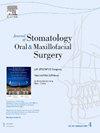Deep learning-based multimodal CT/MRI image fusion and segmentation strategies for surgical planning of oral and maxillofacial tumors: A pilot study
IF 2
3区 医学
Q2 DENTISTRY, ORAL SURGERY & MEDICINE
Journal of Stomatology Oral and Maxillofacial Surgery
Pub Date : 2025-10-01
DOI:10.1016/j.jormas.2025.102324
引用次数: 0
Abstract
Purpose
This pilot study aims to evaluate the feasibility and accuracy of deep learning-based multimodal computed tomography/magnetic resonance imaging (CT/MRI) fusion and segmentation strategies for the surgical planning of oral and maxillofacial tumors.
Materials and methods
This study enrolled 30 oral and maxillofacial tumor patients visiting our department between 2016 and 2022. All patients underwent enhanced CT and MRI scanning of the oral and maxillofacial region. Furthermore, three fusion models (Elastix, ANTs, and NiftyReg) and three segmentation models (nnU-Net, 3D UX-Net, and U-Net) were combined to generate nine hybrid deep learning models that were trained. The performance of each model was evaluated via the Fusion Index (FI), Dice similarity coefficient (Dice), 95th-percentile Hausdorff distance (HD95), mean surface distance (MSD), precision, and recall analysis.
Results
All three image fusion models (Elastix, ANTs, and NiftyReg) demonstrated satisfactory accuracy, with Elastix exhibiting the best performance. Among the tested segmentation models, the highest degree of accuracy for segmenting the maxilla and mandible was achieved by combining NiftyReg and nnU-Net. Furthermore, the highest overall accuracy of the nine hybrid models was observed with the Elastix and nnU-Net combination, which yielded a Dice coefficient of 0.89 for tumor segmentation.
Conclusion
In this study, deep learning models capable of automatic multimodal CT/MRI image fusion and segmentation of oral and maxillofacial tumors were successfully trained with a high degree of accuracy. The results demonstrated the feasibility of using deep learning-based image fusion and segmentation to establish a basis for virtual surgical planning.
基于深度学习的多模态CT/MRI图像融合与分割策略在口腔颌面部肿瘤手术计划中的初步研究。
目的:本初步研究旨在评估基于深度学习的多模态计算机断层扫描/磁共振成像(CT/MRI)融合和分割策略在口腔颌面部肿瘤手术规划中的可行性和准确性。材料与方法:本研究纳入2016年至2022年在我科就诊的30例口腔颌面肿瘤患者。所有患者均行增强CT和MRI口腔颌面部扫描。此外,三种融合模型(Elastix、ANTs和niftyregg)和三种分割模型(nnU-Net、3D UX-Net和U-Net)相结合,生成了九个混合深度学习模型,并进行了训练。通过融合指数(FI)、骰子相似系数(Dice)、第95百分位豪斯多夫距离(HD95)、平均表面距离(MSD)、精度和召回率分析来评估每个模型的性能。结果:三种图像融合模型(Elastix、ANTs和NiftyReg)均表现出令人满意的精度,其中Elastix表现出最好的性能。在测试的分割模型中,NiftyReg和nnU-Net相结合的方法对上颌和下颌骨的分割准确率最高。此外,使用Elastix和nnU-Net组合的9种混合模型的总体精度最高,其肿瘤分割的Dice系数为0.89。结论:本研究成功训练了具有口腔颌面部肿瘤自动多模态CT/MRI图像融合与分割能力的深度学习模型,并取得了较高的准确率。结果表明,利用基于深度学习的图像融合与分割为虚拟手术规划奠定基础是可行的。
本文章由计算机程序翻译,如有差异,请以英文原文为准。
求助全文
约1分钟内获得全文
求助全文
来源期刊

Journal of Stomatology Oral and Maxillofacial Surgery
Surgery, Dentistry, Oral Surgery and Medicine, Otorhinolaryngology and Facial Plastic Surgery
CiteScore
2.30
自引率
9.10%
发文量
0
审稿时长
23 days
 求助内容:
求助内容: 应助结果提醒方式:
应助结果提醒方式:


